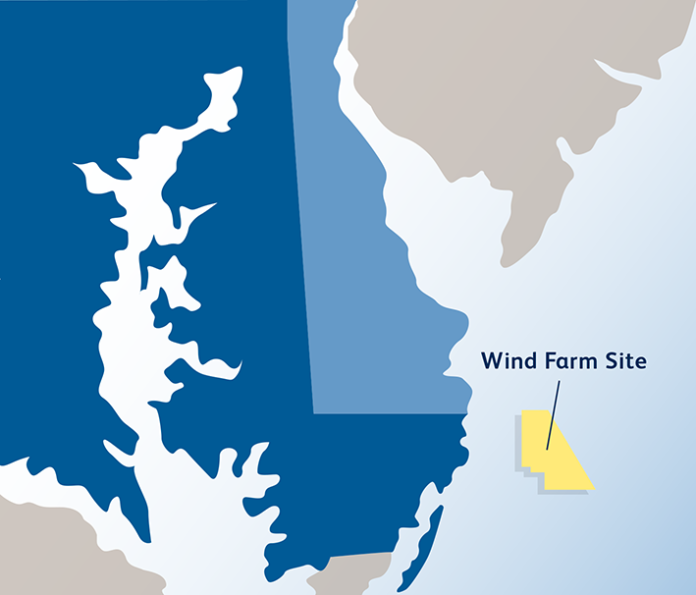US Wind Inc. has declared $11 million in funding over 10 years to the University of Maryland Center for Environmental Science (UMCES) for three research projects aimed at understanding the potential effects of offshore wind development on marine mammals, fish and birds. The research will take place in US Wind’s 80,000-acre federal lease area off the coast of Ocean City, Md.
“As US Wind works to develop offshore wind off Maryland’s coast, it’s imperative that we do so responsibly,” says Jeff Grybowski, US Wind’s CEO. “We’re thrilled to be partnering with UMCES on industry-leading environmental research that will enhance protections for marine life as we develop this clean energy resource for the region.”
“Partnering with a leading environmental research institution like UMCES is an exciting building block in our efforts to collect much-needed biological information in our Lease,” comments Laurie Jodziewicz, US Wind’s senior director of environmental affairs. “The planned work will go a long way in filling knowledge gaps that still exist about offshore wind’s effects on the marine environment.”
“We’re really pleased with this continued partnership with US Wind on important questions related to the environmental impacts of offshore wind development,” adds University of Maryland Center for Environmental Science President Peter Goodwin. “We look forward to working with them along with state and federal agencies to help make the best decisions to minimize impacts to the environment.”
The goal of the eight-year commercial and recreational fisheries monitoring program is to evaluate the extent that black sea bass change their aggregation behaviors before, during and after construction. Black sea bass are structure-oriented with large aggregations occurring on artificial reefs and wrecks. Turbine foundations will add three-dimensional structure within US Wind’s Lease where very little currently exists. This research project will assess the benefits and potential fish aggregation effects. It will also test black sea bass fishing with ropeless gear, an important technology to reduce whale entanglements.
The near real-time whale detection initiative will continue the deployment of a system to provide timely alerts on the presence of baleen whales (North Atlantic right whales, and humpback, fin and sei whales) for a 12-month period from 2022 to 2023. The project is a unique partnership between UMCES and Woods Hole Oceanographic Institution that utilizes specialized quiet mooring technology, whale vocalization detection algorithms and telecommunications to transmit frequent alerts on the presence of baleen whales. The initiative enables continued and real-time data collection through the buoy system that was initially funded by the Maryland Energy Administration and deployed by the Maryland Department of Natural Resources.
The long-term passive acoustic monitoring array research project will support passive acoustic monitoring to detect large whales – such as North Atlantic right whales – and dolphins to understand their presence and migration patterns in and around the lease area and the potential effects of construction. Working with Cornell University’s Center for Conservation Bioacoustics, two types of listening devices will be deployed to determine the occurrence and position of large whales and dolphins, and to detect the tonal echolocation clicks of small cetaceans including porpoises. Additionally, this project will deploy equipment to listen for passing fish, sharks, rays and turtles that have been implanted with transponders for broader scientific research.
“The Department appreciates the coordinated research into safer equipment and marine wildlife monitoring,” states Catherine McCall, director of the Maryland Department of Natural Resources Office of Ocean and Coastal Management. “The ongoing deployment of Maryland’s whale monitoring buoy provides daily detections and helps resource managers protect sensitive species.”
These UMCES-led research projects build on the environmental baseline work US Wind is doing to better understand the environment in and around its lease area and mitigate potential effects of offshore wind development on marine life and avian species. One such initiative, conducted by US Wind through its Normandeau Associates contractor, are aerial digital surveys to identify birds that may be displaced or avoid the wind farm once the turbines are installed. These research and monitoring programs also inform the comprehensive analyses the federal government must do to approve the construction and operation of offshore wind projects.
“The Maryland Energy Administration (MEA) is pleased that offshore wind developers are investing resources to support scientific understanding of the nexus between offshore wind development and the environment, wildlife, ecosystems, and habitats off the coast of Maryland,” says Mary Beth Tung, Ph.D., Esq., director of MEA. “US Wind’s investment compliments the research initiatives funded by MEA and administered by DNR, which total more than $15 million and have been carried out since 2014.”
Monitoring these populations is a critical step in conservation to measure changes, track threats and evaluate the success of wildlife management. The projects were selected based on their efficacy and ability to complement existing research efforts in the scientific community. All data will be made available to government and academic researchers, and reports and information will be made publicly available to help protect these important species and ecosystems for generations to come.




